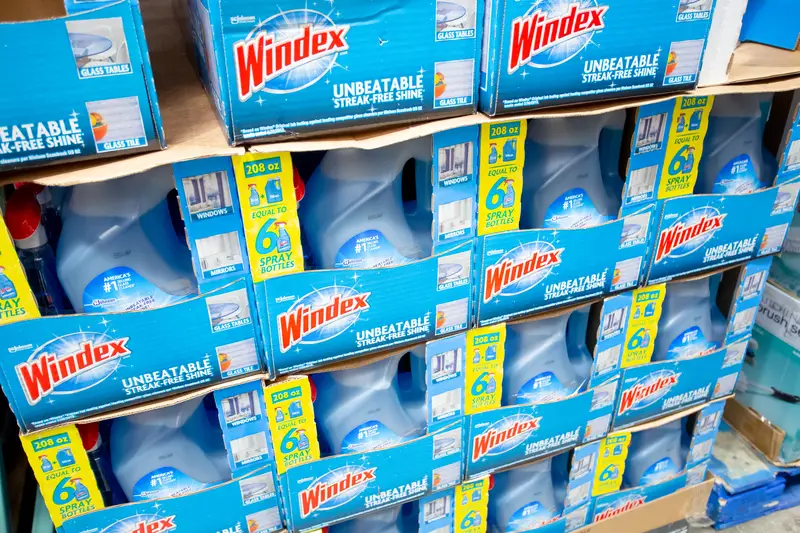Most people grab that familiar blue bottle of Windex whenever something needs cleaning around the house. It seems like the perfect solution for everything from smudged mirrors to grimy countertops. But here’s the shocking truth: using Windex on the wrong surfaces can actually cause permanent damage to your belongings. Those expensive granite countertops, your leather furniture, and even your computer screen could all suffer costly harm from this seemingly harmless cleaner. Understanding what Windex should never touch can save you hundreds of dollars in repairs and replacements.
Plexiglass gets permanently cloudy from ammonia
That clear plexiglass protecting your artwork or covering your outdoor furniture might look like regular glass, but it’s actually much more delicate. When you spray Windex on plexiglass, the ammonia in the cleaner starts breaking down the plastic material almost immediately. What happens next is heartbreaking – the once-crystal-clear surface becomes permanently cloudy, scratched, or discolored. Art gallery owners see this mistake constantly when people try to clean framed pieces at home.
The proper way to clean plexiglass involves nothing more than gentle soap and water applied with a soft microfiber cloth. If you want something specifically designed for the job, ammonia-free glass cleaners work perfectly without causing any damage. The key is being gentle – no scrubbing or harsh chemicals. This simple switch in cleaning products can keep your plexiglass looking new for years instead of ruining it in a single cleaning session.
TV and computer screens warp from chemical exposure
Modern screens have special anti-glare coatings and protective layers that cost manufacturers significant money to apply. When Windex hits these surfaces, the chemicals don’t just clean – they actually start dissolving these expensive coatings. The result is warped plastic, damaged tints, and screens that look worse than before you started cleaning. This damage is permanent and can make your expensive electronics look cheap and distorted.
Electronics manufacturers specifically warn against using household glass cleaners on their products for good reason. Instead, a slightly damp cloth or electronic-specific wipes will safely remove dust and fingerprints. For stubborn marks, a small amount of isopropyl alcohol on a microfiber cloth works wonders without causing damage. The gentle approach takes the same amount of time but preserves your investment in expensive technology.
Granite countertops lose their protective seal
Granite countertops represent a significant investment in most homes, often costing thousands of dollars to install. These natural stone surfaces rely on protective sealants to prevent staining and maintain their beautiful appearance. When Windex contacts granite, the harsh chemicals begin breaking down this protective barrier immediately. Once the seal is compromised, your expensive countertops become vulnerable to permanent stains from coffee, wine, and cooking oils.
Kitchen design professionals see this costly mistake regularly and always recommend neutral stone cleaners specifically formulated for natural surfaces. These specialized products clean effectively while actually helping maintain the protective seal that keeps your countertops looking pristine. The small extra cost of a proper stone cleaner is nothing compared to the thousands you might spend refinishing damaged granite surfaces.
Leather furniture cracks when natural oils disappear
Leather maintains its soft, supple texture through natural oils that keep the material flexible and attractive. These oils are what make leather furniture feel luxurious and comfortable to sit on. When Windex contacts leather, it strips away these essential oils faster than you might expect. The leather then begins drying out, leading to visible cracking, fading, and a cheap, brittle texture that ruins expensive furniture pieces.
Professional furniture restorers recommend leather-specific cleaners and conditioners that remove dirt while actually replenishing the natural oils leather needs to stay beautiful. These products cost roughly the same as Windex but preserve your furniture investment instead of destroying it. Regular conditioning with proper products can keep leather furniture looking new for decades instead of requiring expensive replacement after chemical damage.
Stainless steel appliances develop permanent streaking
Stainless steel appliances cost significantly more than regular models, partly because of their attractive, fingerprint-resistant finishes. Different manufacturers use various coating techniques to achieve that perfect stainless look, and these finishes react unpredictably to standard glass cleaners. What works fine on windows can leave permanent streaks, water spots, or even discoloration on expensive appliances. Professional house cleaners refuse to use Windex on stainless steel because the results are so unpredictable.
Appliance manufacturers and cleaning professionals consistently recommend stainless steel-specific products that clean and polish simultaneously. These cleaners are formulated to work with the various finishes and coatings found on modern appliances. The result is a streak-free, professional appearance that maintains your kitchen’s expensive look instead of creating frustrating cleaning problems that get worse over time.
Shower doors become impossible to clean properly
Bathroom glass faces unique challenges that regular window glass never encounters. Soap scum, hard water deposits, and mineral buildup create stubborn stains that require specialized cleaning approaches. When people use Windex on shower doors, they often find that it simply pushes the soap scum around without actually removing it. Even worse, the cleaner can leave behind residue that actually attracts more dirt and grime, making the problem progressively worse.
Bathroom cleaning specialists recommend targeted soap scum removers or simple vinegar solutions that actually dissolve mineral deposits instead of just spreading them around. Magic erasers work particularly well for stubborn buildup that regular cleaners can’t handle. These approaches address the root cause of shower door grime instead of temporarily masking the problem with products designed for entirely different cleaning challenges.
Wood surfaces dry out and crack permanently
Wood is a natural material that needs moisture to maintain its structural integrity and attractive appearance. Like leather, wood relies on natural oils and proper moisture levels to stay flexible and resist cracking. The ammonia in Windex strips away these protective elements, leaving wood vulnerable to splitting, warping, and permanent damage. This is particularly problematic on expensive hardwood furniture, cutting boards, and outdoor decking, where replacement costs can be substantial.
Wood care specialists recommend food-grade mineral oil treatments and natural wax conditioners that clean while actually protecting the wood surface. These products cost about the same as household cleaners but add protective elements instead of stripping them away. Regular conditioning with appropriate products can extend wood’s lifespan by decades and maintain that rich, natural appearance that makes wood furniture so desirable.
Copper items lose their natural patina forever
Copper develops a beautiful patina over time that many people find more attractive than the original bright finish. This natural aging process creates unique colors and textures that give copper items their distinctive character. When Windex contacts copper, the alcohol and other chemicals react with this patina, causing permanent discoloration that can’t be reversed. What took years to develop naturally gets destroyed in minutes of cleaning.
Antique dealers and copper collectors recommend simple water and microfiber cloth cleaning for most copper maintenance needs. For more thorough cleaning, specialized copper cleaners are formulated to remove dirt and tarnish without damaging the underlying metal or its natural patina. These gentle approaches preserve the value and beauty of copper items instead of accidentally destroying the very characteristics that make them attractive and valuable.
Regular windows get streaky and attract more dirt
Even on regular glass windows where Windex seems like the obvious choice, professional window cleaners avoid it completely. The chemicals in Windex can leave behind residue that actually attracts dust and dirt faster than clean glass would naturally accumulate grime. This means windows cleaned with Windex often look worse sooner than windows cleaned with professional methods. The streaking problem becomes particularly noticeable in bright sunlight, where every imperfection shows clearly.
Professional window cleaners consistently use simple Dawn dish soap mixed with water and proper squeegee techniques to achieve streak-free results that last longer. The fanning method used by professionals leaves zero streaks when done correctly, while household spray cleaners almost always leave some residue behind. This approach costs less than buying bottles of Windex and produces dramatically better results that stay clean longer.
Breaking the Windex habit might feel strange at first, but your home’s surfaces will thank you with longer life and better appearance. Each surface in your home has specific cleaning needs that generic products simply can’t address properly. Taking a few extra minutes to choose the right cleaner for each job prevents costly damage and keeps your belongings looking their best. The small investment in appropriate cleaning products pays huge returns in preserved furniture, appliances, and surfaces that maintain their value and beauty for years to come.

